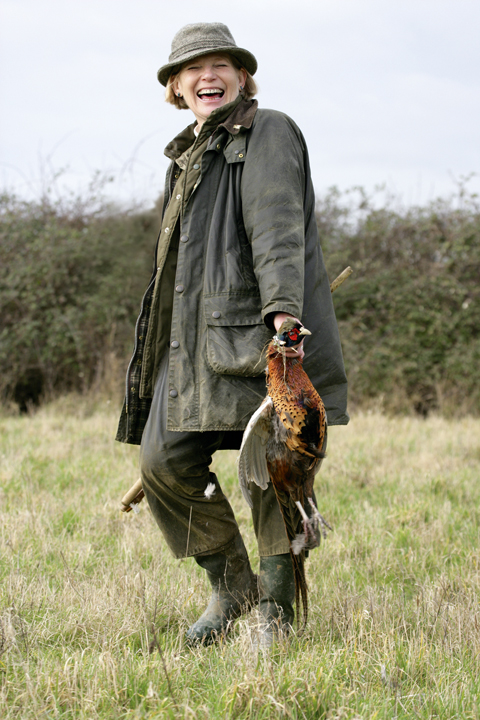Where are all the female gamekeepers?

There are syndicates of lady guns and teams of lady loaders and pickers-up – so why aren’t there more female gamekeepers? Exactly how many exist is impossible to say, but information from the National Gamekeepers’ Organisation and Scottish Gamekeepers’ Association suggests there might be as few as 100 on estates throughout the British Isles.
Female gamekeepers were extremely rare during the Victorian era: perhaps the most famous was Mary Fishburne (aka ‘Polly’) who, for several years, was employed as keeper on the Earl of Leicester’s estate at Holkham. She eventually found herself working in Yorkshire and, when she died there in 1873 aged 80, was buried at All Saints Church, Cawthorne.
In Volume II of his book Fifty Years of my Life, written in 1876, Lord Albemarle remembered Mary thus:
“She had large black eyes, red cheeks, and white teeth, her hair was cropped like a man’s, and she wore a man’s hat. The rest of her attire was feminine. She was irreproachable in conduct, and indeed somewhat of a prude. Polly was the terror of poachers, with whom she had frequent encounters, and would give and take hard knocks, but generally she succeeded in capturing her opponents and making them answer for their misdeeds at Petty Sessions.”
While Mary Fishburne was a female gamekeeper of her own volition, some women came into such employment by default. During the First World War, when most keepers were ensconced elsewhere, some of their wives were pressed into service on the estate. There is, for example, recorded evidence that while a certain Aubrey Trinder, gamekeeper to Lord Abingdon, was away fighting, his wife took over his duties.
More recently, it was the likes of Jill Mason who in the late 1960s led what might have become a flood of females into the male-dominated keepering profession – but which, as it turns out, never became much more than a trickle.
Jill, one of England’s first professional female gamekeepers and nowadays even more well-known as a country writer, says:
“It wasn’t something I planned on doing – I just dropped into it when David [her husband] took a single-handed position and, in the middle of his first rearing season, damaged his knee. That was in 1969. Nowadays that would be fixed with micro-surgery, but then it meant weeks of recuperation. When I left school I’d worked on a poultry-rearing farm so taking over caring for the incubators and rearing chicks was no big deal. Working with him progressed from there and was to last for 30 years.”
It is incubation and rearing at which women seem to excel.
“Female gamekeeping students are almost always better than males at rearing,” says Malcolm Riding of the Northern School of Game and Wildlife based at Newton Rigg. “They have far greater attention to detail and, when it comes to the hard physical work, girls will always find a way of getting round the problem.”

The sport of shooting needs to encourage more lady participants at every level.
“Women are likely to be more conscientious than men in all aspects, and more patient,” adds Jill Mason. “Apart from this being in most women’s natures, there is also the feeling that working in a man’s world means they have a point to prove. However, the downside is lack of physical strength. I’m probably suffering now through stubbornly trying to do my share of lifting and carrying, but modern keepering has changed so much that it is no longer such an issue. For most of my gamekeeping life I was unloading bags manually from a delivery lorry and walking miles, feeding wheat from a heavy feed bag over my shoulder.”
While finding full-time work as a gamekeeper is difficult today, no matter what the sex of the applicant, the availability of college courses makes training easier than ever. However, it appears that, with a few exceptions, only a small proportion of females enrol as students on such courses. Figures from Sparsholt College show that, out of 92 youngsters attending its game and wildlife courses this academic year, nine were female – a typical figure.
At Warwickshire College, there are no girls on its relevant courses this year.
“Not as many girls come forward as we would like – a great shame because they provide a welcome balance and, in some instances, help keep men on the straight and narrow!” says Malcolm Riding.
Ashleigh Miller-Kirkpatrick, a fellow lecturer at Newton Rigg, went as far as becoming qualified in the practical use of firearms and the handling of shot game in an effort to encourage women into gamekeeping – and won the LANTRA Women and Work (Game and Wildlife Management) Learner of the Year Award for 2010/11 in doing so. As reported in Shooting Gazette last year, Mrs Miller-Kirkpatrick said that it would enable her “to become a better teacher of this complex subject, which in time would have a positive impact on gender imbalance in the industry”.
Some 10 years ago, the media made much of young women’s interest in the keepering profession. Portia Simpson, who in 2003 had just become the first woman to complete a two-year gamekeeping course at North Highland College in Thurso, was reported as “more likely to wear designer labels than drab tweed and drives a sports car rather than a battered Land Rover”.
Female gamekeepers do exist but finding one is difficult. There is ample proof they’re out there but few are ever seen – and most are impossible to locate. For instance, while researching this article, I was variously told, “There’s one quite near here who is full-time and been there for several years” and, “I know there is a female gamekeeper at a private shoot near me and she is very highly regarded”. Sadly, despite my own quite reasonable keepering skills, I’ve not yet managed to track one to her lair…
For more features click here








